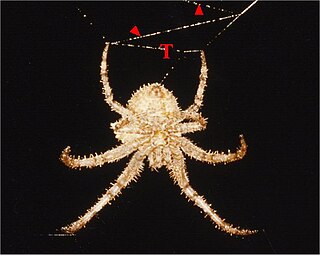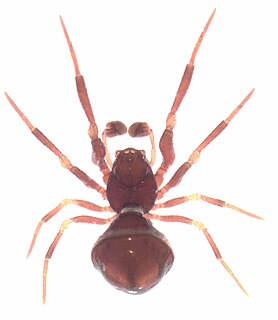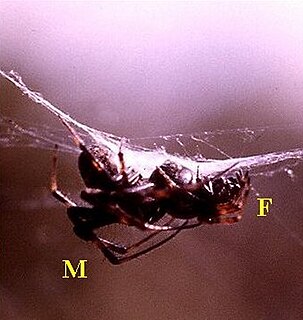
Acanthoctenus is a genus of Central to South American wandering spiders first described by Eugen von Keyserling in 1877.

Kaira, sometimes called frilled orbweavers, is a mostly neotropical genus of orb-weaver spiders first described by O. Pickard-Cambridge in 1889. It includes sixteen described species that occur from South America up to the southern and eastern USA. It is presumably related to Aculepeira, Amazonepeira and Metepeira.

Metepeira is a genus of orb-weaver spiders first described by F. O. Pickard-Cambridge in 1903. The name is derived from the Ancient Greek μετά and the obsolete genus name Epeira, denoting a genus similar to Epeira.

Novanapis is a genus of South Pacific araneomorph spiders in the family Anapidae, containing the single species, Novanapis spinipes. It was first described by Norman I. Platnick & Raymond Robert Forster in 1989, and has only been found in New Zealand.
Dilophus spinipes is a species of March fly in the family Bibionidae.
Eustictus spinipes is a species of plant bug in the family Miridae. It is found in North America.
Caccoplectus spinipes, the spine-legged pselaphid, is a species of ant-loving beetle in the family Staphylinidae. It is found in Central America and North America.
Metepeira ventura is a species of orb weaver in the spider family Araneidae. It is found in the United States and Mexico.
Metepeira arizonica is a species of orb weaver in the spider family Araneidae. It is found in the United States and Mexico.
Metepeira crassipes is a species of orb weaver in the spider family Araneidae. It is found in the United States and Mexico.
Metepeira foxi is a species of orb weaver in the spider family Araneidae. It is found in the United States and Canada.
Metepeira gosoga is a species of orb weaver in the spider family Araneidae. It is found in the United States and Mexico.
Metepeira grandiosa is a species of orb weaver in the spider family Araneidae. It is found in North America.
Metepeira palustris is a species of orb weaver in the spider family Araneidae. It is found in the United States and Canada.
Metepeira pimungan is a species of orb weaver in the spider family Araneidae. It is found in the United States.
Metepeira comanche is a species of orb weaver in the spider family Araneidae. It is found in the United States and Mexico.
Euscaphurus spinipes is a species of plate-thigh beetle in the family Eucinetidae. It is found in North America.
Metepeira minima is a species of orb weaver in the spider family Araneidae. It is found in a range from the United States to Honduras.
Metepeira datona is a species of orb weaver in the spider family Araneidae. It is found in the United States and Greater Antilles.

Metepeira incrassata, also known as the colonial orb-weaving spider, belongs to the spider family Araneidae and genus Metepeira. They are most famous for their social organization and group living behavior. They are generally found in tropical rainforest and agricultural sites in Mexico, and their habitats tend to be highly productive. Their group sizes are relatively larger than other colonial spiders, typically ranging from hundreds to thousands of individuals. 99% of the females are observed to participate in colonial living, generally with at least two other individuals. Because most M. incrassata females are communal, the colonies are often dominated by larger males. There is minimal sexual dimorphism observed in M. incrassata. Unlike other orb-weaver spiders, M. incrassata builds a colonial web by connecting each spider's individual webs together through semi-permanent framelines. These colonial webs of M. incrassata are prone to invasion by kleptoparasitic and araneophagic spiders such as the Theridiidae family. The reproductive cycle of M. incrassata occurs throughout the entire year, with multiple generations sharing the same time period. Within their colonies, M. incrassata is seen to change locations. Larger, fertile females with egg sacs prefer to reside in the central area of the group for increased protection from predators, while the younger spiders are mostly found in peripheral positions. Larger adult M. incrassata are also known to finish web-building earlier than smaller ones, gaining an advantage in strategically positioning themselves.




